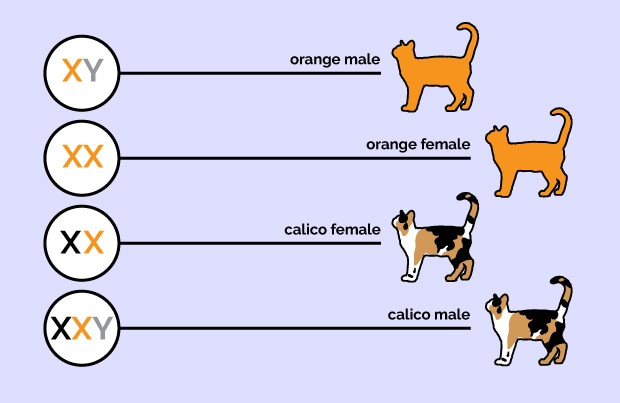You might have heard the common saying that orange cats are usually male. Perhaps you’ve even noticed this trend yourself. It’s a widely accepted piece of feline trivia, but is there any truth behind it? The answer lies in the fascinating world of feline genetics and the unique way coat color is determined in cats. Let’s delve into the science to understand why orange cats are predominantly male, and explore the exceptions to this furry rule.
The X Chromosome and Cat Coat Color
To understand the link between orange fur and gender, we need to revisit some basic biology. Just like humans and other mammals, a cat’s sex is determined by two chromosomes: XX for females and XY for males. However, the genes responsible for coat color are located on the X chromosome. Specifically, the orange gene, which dictates whether a cat will display orange or black pigment, resides on this chromosome.
As Dr. Jerold Bell, adjunct professor of genetics at Cummings School of Veterinary Medicine at Tufts University, explains, the genes for black and red (orange) are alleles. This means they are different versions of the same gene found at the same location on the X chromosome. An X chromosome can carry either the allele for orange fur or the allele for non-orange fur (which typically defaults to black), but not both simultaneously.
Dr. Susan Konecny, medical director for Best Friends Animal Society, further clarifies this. “One allele will create orange coloration. This allele will cover up all other colors, except pure white. The other allele will create a non-orange coloration. This allele is ‘recessive’ and allows for expression of a non-orange (usually black) coloration.” Essentially, the orange gene is dominant in terms of producing orange pigment.
Males, with their XY chromosome makeup, inherit only one X chromosome – from their mother. This means a male cat will either inherit the orange gene from his mother and be orange, or inherit the non-orange gene and be black (or a variation thereof, depending on other genes). They cannot inherit both orange and non-orange genes because they only have one X chromosome to work with.
Females, on the other hand, have two X chromosomes (XX), inheriting one from each parent. This opens up the possibility for them to inherit two color alleles – potentially one orange and one non-orange.
Why Orange Cats Are Predominantly Male
So, why does this genetic dance lead to more male orange cats? It boils down to probability and the way these genes are inherited.
As Dr. Bell states, approximately 81 percent of orange cats are male. This is because a male cat only needs to inherit a single orange gene from his mother to display an orange coat. If his X chromosome carries the orange gene, he will be orange, regardless of the genes on the Y chromosome (which doesn’t carry color information).
For a female cat to be orange, she must inherit the orange gene from both her parents – one orange gene from her mother and one from her father. Given that the orange gene is less common in the overall cat population compared to the non-orange gene, the probability of a female cat inheriting two orange genes is statistically lower. This is why orange female cats are less frequently seen than their male counterparts.
Consider the inheritance patterns:
- Orange Mother Cat: All male kittens will be orange, regardless of the father’s color, as they will inherit the orange X chromosome from their mother.
- Tortoiseshell Mother Cat (orange and black mix): Half of her male kittens will be orange (inheriting the orange X chromosome) and half will be black (inheriting the non-orange X chromosome).
- To get an orange female kitten: Both the mother and father must contribute an orange gene. If the mother is tortoiseshell and the father is orange, there is a 50% chance of female kittens being orange.
 Cat chromosome chart
Cat chromosome chart
A chart illustrating cat chromosomes and their relation to coat color inheritance, showing how X and Y chromosomes determine sex and how the X chromosome carries the orange gene.
Exceptions to the Rule: Female Orange Cats
While statistically less common, female orange cats absolutely exist. They are a beautiful testament to the nuances of genetics. As explained earlier, a female cat will be orange if she inherits the orange gene on both of her X chromosomes. This typically happens when both parents carry the orange gene, increasing the likelihood that a female offspring will receive two copies.
The relative rarity of female orange cats simply reflects the lower frequency of the orange gene in the general cat population. Think of it like rolling dice – it’s less probable to roll double sixes than to roll any other combination. Similarly, it’s less probable for a female cat to inherit two orange genes compared to a male cat inheriting just one.
What About Calico Cats?
The discussion of orange cats and gender often brings up calico cats. Calico cats, with their distinctive tri-color coats of white, black, and orange, are overwhelmingly female. This is also due to the X chromosome.
According to Dr. Stephanie Karpf, a veterinarian at For Cats Only in West Palm Beach, Florida, “For a cat to be a calico, it must have two X chromosomes, and typically only female cats have two X chromosomes.” The presence of two X chromosomes in females allows for the expression of both the orange and non-orange alleles, along with a separate gene for white spotting, resulting in the calico pattern.
While male calico cats are incredibly rare (estimated at less than 1 in 1,000), they can occur due to genetic anomalies. One such anomaly is the XXY chromosome condition. These cats are genetically male but possess an extra X chromosome. If one X chromosome carries the orange gene and the other carries the non-orange gene, the resulting cat can be a male calico. However, these male calico cats are usually sterile due to the chromosomal abnormality. Another rare cause is chimerism, where two embryos fuse in early development, resulting in a cat with two sets of DNA, potentially leading to a male calico.
Conclusion: The Ginger Gender Mystery, Mostly Solved
So, to answer the question “Are All Orange Cats Male?” – the answer is a resounding no, but overwhelmingly, yes. The fascinating genetics of feline coat color, specifically the location of the orange gene on the X chromosome, makes it statistically more likely for orange cats to be male. Female orange cats are less common but certainly not mythical creatures.
The link between coat color and gender in cats is a captivating example of how genetics plays a role in the diverse characteristics we see in our feline companions. Next time you see a ginger cat, you can make an educated guess about its gender, knowing the science behind this charming feline phenomenon.

